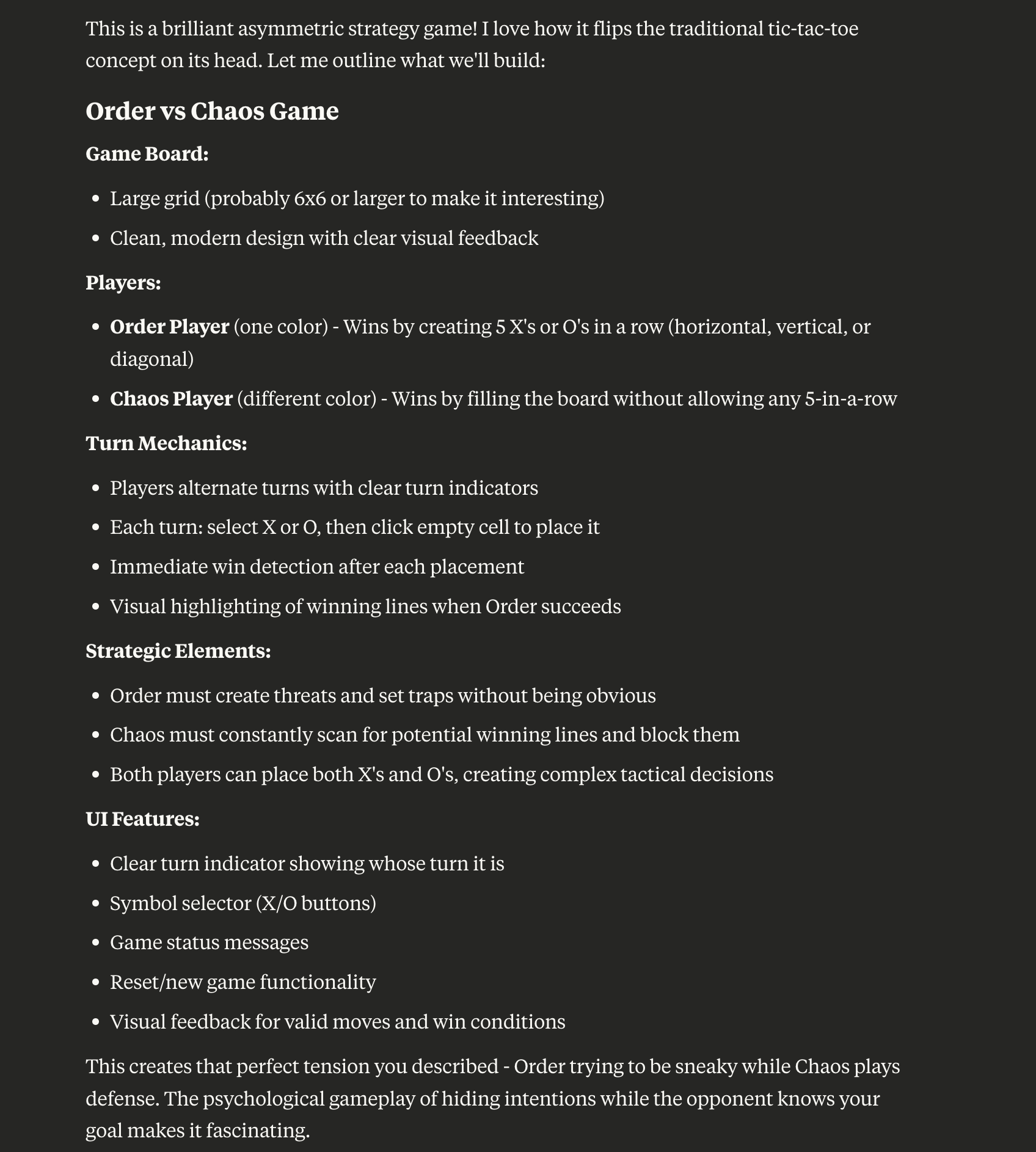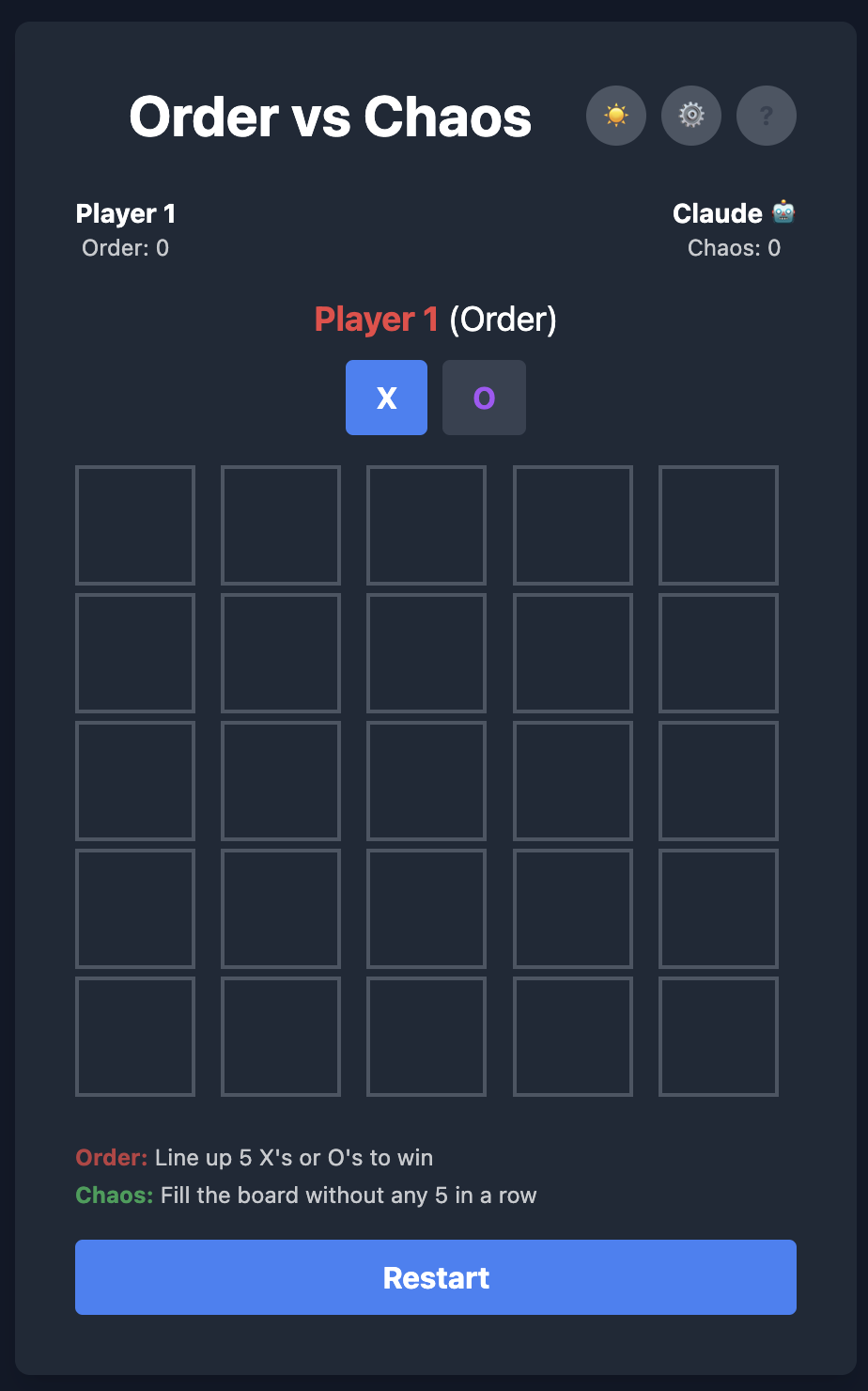In the past year, large language models (LLMs) like Claude have become a regular part of my workflow. I’ve used them for everything from rephrasing documentation drafts to debugging code and occasionally asking them to “explain this to me.”
But almost all of that has been serious, structured and focused on productivity, AI as a tool to get work done faster or more efficiently.I rarely stopped to think about how these tools could be used for fun, curiosity or even play.
That changed one evening thanks to two completely unrelated events:
- My younger sister introduced me to a game called Chaos and Order.
- Anthropic announced you could now embed Claude into artifacts, giving it more interactive and persistent behavior.
That coincidence sparked a simple, slightly ridiculous idea: what if I could build Chaos and Order into an artifact and then play against Claude?
A Simple Prompt, A Creative Spark
Knowing from experience that overly ambitious prompts tend to disappoint, I kept things basic. I asked Claude to read the rules of the game and build a local multiplayer version - just something I could test and interact with.
The game is simple in design but elegant in challenge:
- It’s played on a 6×6 grid.
- On each turn, a player selects either an “X” or an “O” and places it anywhere on the board.
- Symbols don’t belong to either player.
- Order’s goal is to create a line of 5 identical symbols in a row (horizontally, vertically or diagonally).
- Chaos’s goal is to prevent that from happening by filling the grid in a way that blocks any winning opportunity.
What makes it interesting is the psychological angle: Order’s intentions are obvious, while Chaos plays reactively - always trying to read ahead and spot the trap. Order must be clever and subtle; Chaos must be sharp and vigilant.
Try playing Chaos and Order here →
Claude quickly understood the rules and responded with enthusiasm, asking me questions about gameplay mechanics, visual layout and user interactions.

Within a few iterations, we had a working prototype - simple, functional and kind of fun.
Integrating Claude as a Player
With the basic game running, I wanted to take it a step further: could Claude play the game itself?
I asked it to build a single-player mode where the user plays against Claude. Impressively, it not only built the mode but added thoughtful UX features like:
- AI game toggle: Switch between playing against Claude or another human.
- Thinking indicator: A short delay with a “Thinking…” message to simulate human response time.
- Emoji avatar: Claude appears with a 🤖 emoji, making it easy to distinguish.
- Adaptive logic: Claude analyzes the board, understands its role (Chaos or Order) and makes moves accordingly.

Under the hood, Claude evaluates current patterns on the grid, predicts potential outcomes and chooses strategic responses. As Order, it looks to build undetected lines. As Chaos, it blocks, disrupts and redirects. It even handles tie conditions and rare edge cases where players force a draw.
But what really stood out to me wasn’t the quality of the game, it was the feeling of building alongside Claude. I wasn’t just feeding it instructions. I was bouncing ideas off it, adjusting based on its suggestions and letting it lead sometimes. It felt more like a partnership than a toolchain.
A Playable and Purposeful Artifact
The final product was more than just a game. It was a hands-on demonstration of how AI can support curiosity, experimentation and rapid prototyping. You can play it here.
There were moments where the AI misunderstood or made a less-than-optimal move but that was part of the charm. I could tweak it, iterate and learn along the way. I wasn’t aiming for perfection; I was exploring possibility.
Conclusion: Work, Play and the Space In Between
Working on Chaos and Order reminded me that AI doesn’t always have to be practical or productive to be valuable. It can be a sandbox for creativity, a place to tinker, learn and even just play.
This project wasn’t part of a big launch or client deliverable. I wasn’t trying to make a perfect product. I was exploring. I was learning through play.
And surprisingly, I learned a lot about game design, decision trees and even my own assumptions around user experience.
🧠 Fun fact: I had never made a game before. Thinking through the rules forced me to consider how people (or agents like Claude) interact with constraints, strategies and each other.
That intersection of work and play - of learning through curiosity - is where I think a lot of future use cases for AI will emerge. Not just to save time, but to expand how we think, build and experiment.
🎮 Play Chaos and Order against Claude

